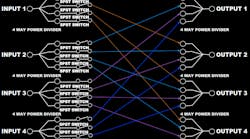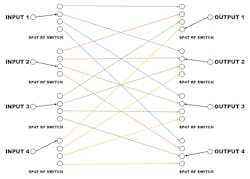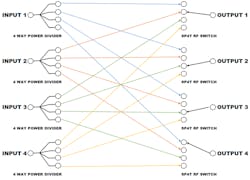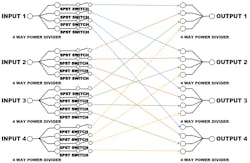RF Switch Matrices: To Block or Not to Block?
Download this article in PDF format.
What you’ll learn:
- The three basic types of RF switch matrices: blocking, non-blocking, and super non-blocking.
- The key electrical parameters that determine how a given switch matrix performs.
- The interdependencies that exist between various electrical parameters.
RF switch matrices eliminate the need to manually move connections by routing signals, via user control, from their input ports to their output ports, providing convenience and speed to many industrial applications. They can be applied in production environments for switching test equipment like signal generators, spectrum analyzers, network analyzers, and power meters to a device under test.
A switch matrix also can be used to create redundancy paths to backup equipment, like feeds from antennas to modulators. Another application in the lab is to split and distribute a signal to multiple places or create multiple signal paths with differing characteristics such as delay, frequency response, or attenuation.
Switch-Matrix Types
There are three types of matrices that provide different functionality: blocking, non-blocking, and super non-blocking. All types are denoted as NxM, where the letter N designates the quantity of input ports, and the letter M indicates the number of output ports. For example, a matrix designated as a 4 × 4 has four input ports and four output ports. A switch matrix could be as simple as a 1 × 2, as complex as a 256 × 256, or anywhere in between.
Blocking Switch Matrices
A blocking switch matrix allows an input port to be connected to any of its output ports. At any given instant, an input can only be connected to one output and each output can only be connected to one input. In a blocking matrix, the number of active connections is limited to the number of input or output ports, whichever is less. For example, a 1 × 4 blocking switch matrix can only have one active connection at a time.
Figure 1 shows the possible pathways that exist in a 4 × 4 blocking switch matrix. This type of switch matrix can be realized using eight single-pole, four-throw switches and 16 interconnecting cables. Examining the diagram shows that there can only be four simultaneous connections. In addition, at any given instant, a single input can be connected to one of the outputs and that one output can only be connected to one input.
Non-Blocking Switch Matrix
Another type of RF switch matrix is the non-blocking type. In this case, an input can be simultaneously connected to multiple outputs, but, at any instant, each output can only be connected to one of the inputs. To provide this functionality, each input signal is split using a power divider.
Figure 2 shows the possible interconnections in a 4 × 4 non-blocking switch matrix. This switch matrix requires four 4-way power dividers; four single-pole, four-throw switches; and 16 interconnecting cables. Because the power dividers split the input signal four ways, always providing a copy of each input to each output, a single input may be connected to any number of outputs at the same time. Each input must be split, though, so the signal at each output is a lower amplitude than the input signal.
Super Non-Blocking Switch Matrix
The last of the switch-matrix architectures is the super non-blocking type, which allows the inputs to be simultaneously connected to multiple outputs and the outputs to be simultaneously connected to multiple inputs. To achieve this level of connectivity, each input signal must be split to divide the input signal to all outputs and each output must use a combiner to sum the signals from each input onto a common output.
Figure 3 illustrates a 4 × 4 super non-blocking switch matrix. It consists of eight power dividers (four of which split the input signal while four others serve as combiners at the output); 16 single-pole, single-throw switches; and 16 interconnecting cables. As the diagram shows, any number of inputs can be connected to any number of outputs simply by opening or closing the appropriate switch. Because splitters and combiners are needed at the input and output, the signal level at the output is lower in amplitude than the input signal.
Electrical Parameters
Besides the basic functional types of blocking, non-blocking, and super non-blocking, certain electrical parameters are common to all switch matrices. They include operating frequency, insertion loss, isolation, switching time, and operational power level.
The requirements for any of those parameters can drive the switch-matrix design and limit what’s obtainable for the remaining parameters. As such, tradeoffs must often be made in the overall specifications to meet the critical requirements for a given application.
Operating Frequency
The frequency range of the RF signal that can pass from a matrix’s input port to its output is its operating-frequency range. Matrices can be designed to operate over a wide frequency range such as dc to 40 GHz, or a narrower range like 2.4 to 2.5 GHz. The wider the bandwidth of a matrix, the more cost it will entail. Also, operation down to dc or very low frequencies limits the types of switches that can be used to build the matrix and will impact other specifications such as switching speed and insertion loss.
Insertion Loss
The insertion loss of a switch matrix is a measure of the RF signal power lost as the signal travels from the input to the output. The loss is measured in decibels; any components (splitters, switches, cabling, and so on) in the signal path contribute to the insertion-loss value. The non-blocking and super non-blocking matrices inherently exhibit higher insertion loss than a blocking matrix simply because they require power dividers and power combiners in addition to switches. The super non-blocking matrix has the highest insertion loss.
Required bandwidth could further impact the insertion loss. Power dividers that operate over a wide frequency range, such as 1 to 40 GHz, incur more insertion loss than narrower-band devices. The same is true of power dividers that operate down to dc. Higher insertion loss can be expected with wider operating bandwidths and lower operating frequencies unless other measures are taken.
Amplifiers can be added to the matrix signal paths to boost the signal’s power level, offsetting any component losses and keeping the insertion loss low. But amplifiers can’t be added if the matrix must be bidirectional, allowing signals to flow from input to output as well as from output to input. Adding amplifiers will make the matrix unidirectional, so that signals can flow in only one direction, from input to output. Therefore, if bidirectionality is necessary in your RF switch matrix, forget about amplifiers.
Isolation
Isolation is a measure of the signal power loss through a matrix when a path is turned off. It also indicates the loss between ports that are never directly connected. Isolation can be measured from input to output, input to input, or output to output. In all cases, the higher the isolation, the better. In some applications, very high isolation is desired to keep signals from different ports or paths from leaking into each other and causing interference.
Switching Time
Switching time refers to how long it takes a switch matrix to disconnect from one path and establish a new path connection. The switching time is measured with respect to a control signal that tells the switch matrix to change states.
The elapsed time from the dispatch of the control signal to when the RF signal is at 10% (for the path being disconnected) or 90% (for the newly connected path) of its final voltage is the switching time. During the switching-time interval, the control signal must be processed and all necessary switches set to the proper state. This parameter is primarily set by delays in the matrix control circuitry and the characteristics of the signal switches.
The types of switches used within the matrix will significantly affect the switching time. Mechanical switches, such as coaxial relays or waveguide switches, are the slowest and have switch times in the tens of milliseconds. PIN-diode- and FET-based switches are the fastest and can have switch times in the tens of nanoseconds. If your goal is the fastest possible switching time, it can drive other characteristics of the switch matrix.
As mentioned, matrix control methods also influence switching time. For example, if the control signal is delivered via a network connection, time is required for the signal to be routed through the communications network as well as for the controller within the matrix to receive and decode the control signal. Switch matrices with critically fast switching times require low-latency, direct-connected control signals. In applications where pre-defined and sequenced switching needs to happen at the highest speeds, a program can be pre-loaded into the switch matrix and then run by issuing a single command to the switch matrix.
RF Power Levels
The RF-signal power levels that the switch matrix must pass will impact the overall performance specifications. The different types of switches used for matrix construction have varying operating power levels. Mechanical coaxial relays can handle from tens to thousands of watts depending on the signal frequency. PIN-diode switches and FET-based switches can handle power in the tens to hundreds of watts.
The other factor limiting RF power levels into the switch matrix is the presence of signal amplifiers. Switch matrices that contain amplifiers to offset losses must be designed with the input-signal power levels in mind. Incorrect sizing or placement of the amplifier will have adverse effects such as signal distortion and possible component damage. Care must be taken to properly design the matrix for best possible performance at the required RF signal levels.
Controls
Switch matrices can be controlled manually or by a computer. Typically, both types are provided, with a front-panel knob or touchscreen being common for manual control. For computer control, discrete control bits, Ethernet, RS-232, or USB are common. The protocol used for computer control can be customized to meet to specific user requirements.
Reliability
Switch-matrix reliability is largely driven by the type of switches used. Mechanical coaxial relays have a limited life, typically 1 million cycles, so they’re the least reliable. Higher-reliability coaxial relays that offer 10 million cycles are available, but they’re more costly. PIN-diode- and FET-based switches are electronic, have higher reliability, and theoretically never wear out. Thus, it’s preferable to build switch matrices around PIN-diode- and FET-based switches, provided they won’t impede other requirements.
Conclusion
We’ve shown that many possible options and tradeoffs must be considered when choosing an RF switch matrix. The first choice is to select the type of switch matrix from among the blocking, non-blocking, and super non-blocking architectures. Next, decide on the important electrical parameters and resolve any tradeoffs between conflicting requirements.
In addition to what’s presented here, custom features can be incorporated and should be considered at the start. Considering all of these factors will ensure a smooth sourcing process, and you’ll end up with a switch matrix that will meet expectations.



